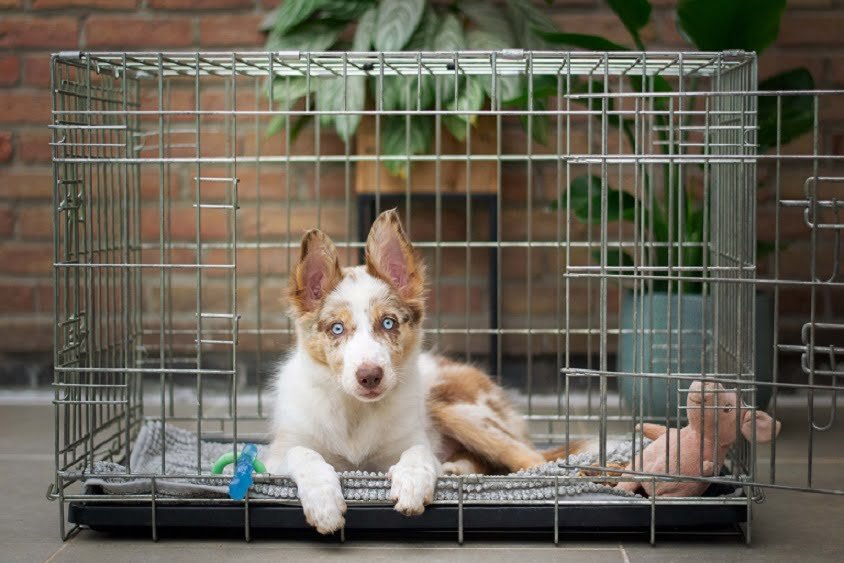Crate training is a highly effective method for dog owners looking to establish a safe and comfortable space for their canine companions. Whether you’re bringing home a new puppy or working on behavioral issues with an older dog, crate training can be a valuable tool in your pet parenting toolkit. In this comprehensive guide, we’ll explore seven essential tips to help you successfully crate train your dog.
Choose the Right Crate
Selecting the appropriate crate is the foundation of successful crate training. The crate serves as your dog’s den, so it’s essential that it’s comfortable and secure. Here’s what to consider:
- Size Matters: Ensure the crate is spacious enough for your dog to stand up, turn around, and lie down comfortably. However, it shouldn’t be excessively large, as dogs tend to avoid soiling in confined spaces. Consider your dog’s eventual size when choosing a crate, and if you have a puppy, opt for an adjustable crate that can grow with them.
- Material and Design: Crates come in various materials, with the two most common types being wire crates and plastic crates. Wire crates offer excellent ventilation and visibility, making them suitable for dogs who may feel anxious in confined spaces. Plastic crates, on the other hand, provide a more den-like environment, which some dogs find comforting.
- Portability: If you plan to travel with your dog, consider a crate that is easy to transport. Many crates are collapsible, making them convenient for on-the-go pet parents.
Introduce Gradually
Introducing the crate to your dog should be a slow and positive process. Here’s how to make the initial introduction a success:
- Placement: Start by placing the crate in a common area where your dog spends time, like the living room. Ensure it’s on a stable surface and won’t wobble or tip over.
- Leave the Door Open: Initially, leave the crate door open, allowing your dog to explore it at their own pace. Do not force your dog into the crate; instead, let them approach it voluntarily.
- Positive Association: Make the crate an inviting space by placing treats, toys, or a soft blanket inside. This creates a positive association between the crate and pleasant experiences.
Positive Associations
Building positive associations with the crate is crucial for your dog’s acceptance of it as their safe haven. Here’s how to achieve this:
- Reward with Treats and Praise: When your dog voluntarily enters the crate, offer treats and praise. Shower them with affection to reinforce the idea that the crate is a wonderful place to be.
- Avoid Punishment: Never use the crate as a form of punishment. It should always be a place of comfort and security for your dog. If you use it for punishment, your dog may develop negative associations and resist entering the crate.
Mealtime in the Crate
One effective way to make the crate an appealing place is by incorporating it into your dog’s mealtime routine:
- Gradual Progression: Begin with the crate door open during mealtime. Place your dog’s food bowl inside, allowing them to eat comfortably while seeing that the crate is a safe environment.
- Closing the Door: As your dog becomes accustomed to eating in the crate with the door open, start closing the door for short periods while they eat. Gradually increase the duration as your dog becomes more comfortable.
- Positive Reinforcement: Use mealtime in the crate as an opportunity for positive reinforcement. Offer verbal praise and treats when your dog finishes their meal without signs of anxiety or stress.
Gradual Lengthening of Time
Crate training is a gradual process that requires patience and consistency. Here’s how to extend the time your dog spends in the crate:
- Start Slowly: Initially, close the crate door for just a few minutes while you’re present. This helps your dog associate being in the crate with your presence and provides a sense of security.
- Increase Duration: Gradually extend the time your dog spends in the crate with the door closed. Begin with short intervals and work your way up to longer periods. Ensure your dog remains calm and relaxed during these sessions.
- Practice When You’re Home: To prevent separation anxiety, practice crating your dog even when you’re at home. This helps your dog understand that being in the crate is a normal part of their routine, not just a response to your absence.
Ignore Whining
It’s common for dogs to whine or bark when first introduced to crate training. Here’s how to handle these vocal protests:
- Stay Calm: When your dog whines or barks in the crate, it’s essential to remain calm. Do not react with frustration or anger, as this can exacerbate the behavior.
- Avoid Immediate Release: Resist the temptation to open the crate and let your dog out as soon as they start whining. Doing so can reinforce the idea that whining leads to freedom.
- Wait for Quiet: Instead, wait for a moment of quiet before opening the crate. Reward your dog with praise and treats when they are calm. This helps them understand that quiet behavior is desirable.
Create a Routine
Consistency is key to successful crate training. Establish a routine to help your dog adapt to the crate as a regular part of their daily life:
- Scheduled Crate Time: Use the crate for specific times, such as bedtime, when you’re away from home, and for short breaks during the day. Having a structured schedule helps your dog anticipate crate time.
- Use a Cue Word: Introduce a cue word like “crate” or “bed” to signal to your dog that it’s time to enter the crate. Pair this word with treats or toys to reinforce the association.
- Comfort in the Crate: Make the crate cozy with a comfortable bed or blanket. However, avoid using anything that your dog might chew or ingest. The goal is to create a relaxing and safe environment.
Additional Tips:
- Exercise and Bathroom Breaks: Ensure your dog has had sufficient exercise and bathroom breaks before crating to reduce restlessness.
- Avoid Extended Crating: While crate training can be valuable, avoid keeping your dog crated for extended periods. Dogs need exercise, mental stimulation, and social interaction.
- Monitor Temperature: Be mindful of the temperature in the room where the crate is located. Ensure it’s neither too hot nor too cold, and provide adequate ventilation.
- Regular Check-Ins: When you first start crate training, periodically check on your dog to ensure they are comfortable and not exhibiting signs of distress.
- Consult a Professional: If you encounter significant challenges or your dog exhibits severe anxiety while crated, consider seeking guidance from a professional dog trainer or behaviorist.
Crate training is a valuable tool for dog owners when done correctly and with patience. It offers numerous benefits, including aiding in housebreaking, managing behavioral issues, and providing a secure space for your dog. By following these seven essential tips and additional guidelines, you can create a positive and successful crate training experience for both you and your beloved canine companion. Remember that every dog is unique, so adapt these tips to suit your dog’s individual needs and personality, and enjoy the benefits of a well







